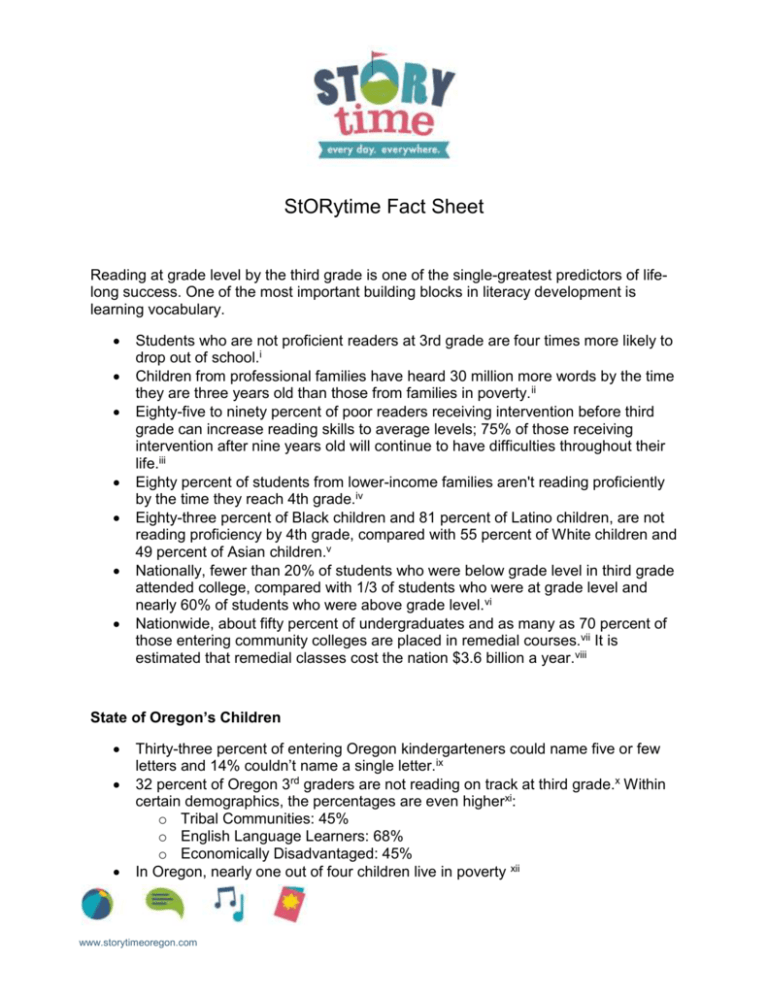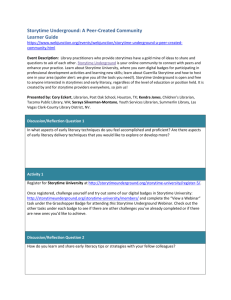Story Time Fact Sheet ()
advertisement

StORytime Fact Sheet Reading at grade level by the third grade is one of the single-greatest predictors of lifelong success. One of the most important building blocks in literacy development is learning vocabulary. Students who are not proficient readers at 3rd grade are four times more likely to drop out of school.i Children from professional families have heard 30 million more words by the time they are three years old than those from families in poverty. ii Eighty-five to ninety percent of poor readers receiving intervention before third grade can increase reading skills to average levels; 75% of those receiving intervention after nine years old will continue to have difficulties throughout their life.iii Eighty percent of students from lower-income families aren't reading proficiently by the time they reach 4th grade.iv Eighty-three percent of Black children and 81 percent of Latino children, are not reading proficiency by 4th grade, compared with 55 percent of White children and 49 percent of Asian children.v Nationally, fewer than 20% of students who were below grade level in third grade attended college, compared with 1/3 of students who were at grade level and nearly 60% of students who were above grade level.vi Nationwide, about fifty percent of undergraduates and as many as 70 percent of those entering community colleges are placed in remedial courses.vii It is estimated that remedial classes cost the nation $3.6 billion a year.viii State of Oregon’s Children Thirty-three percent of entering Oregon kindergarteners could name five or few letters and 14% couldn’t name a single letter.ix 32 percent of Oregon 3rd graders are not reading on track at third grade.x Within certain demographics, the percentages are even higherxi: o Tribal Communities: 45% o English Language Learners: 68% o Economically Disadvantaged: 45% In Oregon, nearly one out of four children live in poverty xii www.storytimeoregon.com Parents and caregivers are a child’s most important first teacher. Parents have the greatest influence on the achievement of young people; parental involvement with reading activities at home has significant positive influences on reading achievement, language comprehension and expressive language skills.xiii Parents and caregivers face a variety of obstacles that prevent them from focusing in early reading with their children, such as language barriers, lack of understanding on how to engage children in day-to-day activities, and misperceptions about their role as a child’s “teacher” outside of the classroom. Every moment can be a teaching moment. Families can easily support early literacy for their children in every day activities, such as grocery shopping, going on a walk, singing a song, telling a story or making a meal. Critical vocabulary development that creates a foundation for reading well can be built around activities like playing, talking, singing and reading. About stORytime: Oregon's 40-40-20 goal by 2025 is predicated on building a seamless system of education from birth to college and career. The goal calls for 40 percent of students to receive a bachelor's degree or higher; 40 percent of students to receive an associate degree or certificate; and the remaining 20 percent to earn a high school diploma. Ensuring that students on track to be reading by third grade is one of the best opportunities we have as a state to reach 40-40-20. stORytime builds awareness and shared responsibility for ensuring that every child in Oregon is a proficient reader by the third grade. Created in collaboration with communities across Oregon, stORytime draws attention to the power of words and language in building literacy and creates easy ways families can help their children every day, everywhere, through books, stories, songs and play. The campaign is designed to complement existing strategies and investments preparing students for kindergarten and 3rd grade reading proficiency both within the education system and by community partners around the state. The ultimate goal for the stORytime initiative is to ensure every child in the state of Oregon has access to literacy-rich environments and is proficient in reading by the third grade. In the short-term, the initiative will: o Increase awareness about the importance of early literacy for lifelong success. o Identify and seek to diminish barriers related to early literacy building so more children have every opportunity to succeed. o Identify effective community-driven and culturally specific strategies for building early literacy skills for children. o Through partnerships, galvanize communities across the state to support families and collectively impact literacy building in their community. Learn more about stORYtime: i ii Website: www.storytimeoregon.com Twitter: o @ORLearns o #storytimeoregon o #PlayTalkReadSing Facebook: StORytime Oregon YouTube http://gradelevelreading.net/wp-content/uploads/2012/01/Double-Jeopardy-Report-030812-for-web1.pdf Hart, B., Risley, T. (Spring 2003). The Early Catastrophe; The 30 Million Word Gap by Age 3. American Educator. iii Lesnick, J., Goerge, R., Smithgall, C., & Gwynne J. (2010). Reading on Grade Level in Third Grade: How Is It Related to High School Performance and College Enrollment? Chicago: Chapin Hall at the University of Chicago . iv http://www.aecf.org/resources/early-reading-proficiency-in-the-united-states/ v http://www.aecf.org/resources/early-reading-proficiency-in-the-united-states/ vi Lesnick, J., Goerge, R., Smithgall, C., & Gwynne J. (2010). Reading on Grade Level in Third Grade: How Is It Related to High School Performance and College Enrollment? Chicago: Chapin Hall at the University of Chicago. vii Report was issued by the Charles A. Dana Center at the University of Texas, Complete College America, Education Commission of the States, and Jobs for the Future, December 2012. viii http://community.pearson.com/collegereadiness/college-career-readiness/the-cost-of-remediationpreparing-students-for-college-success/ ix “Kindergarten Assessment Data.” Oregon Department of Education and the Early Learning system. Jan. 2014. x Oregon Department of Education OAKS Test Results 2014 xi Oregon Department of Education OAKS Test Results 2014 xii “A Graphic View of Poverty in Oregon.” Oregon Center for Public Policy. N.p., n.d. Web. 22 Jan. 2014. http://www.literacytrust.org.uk/assets/0000/7901/Research_reviewimportance_of_families_and_home.pdf xiii www.storytimeoregon.com







